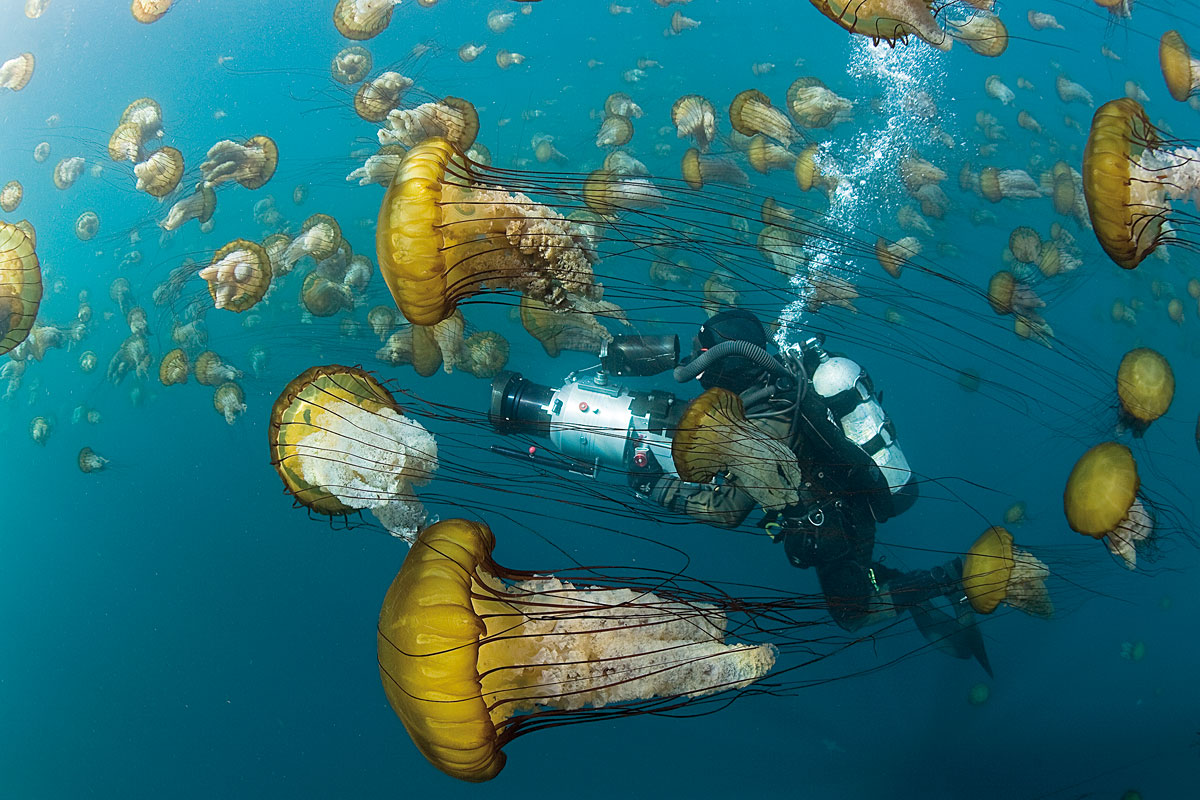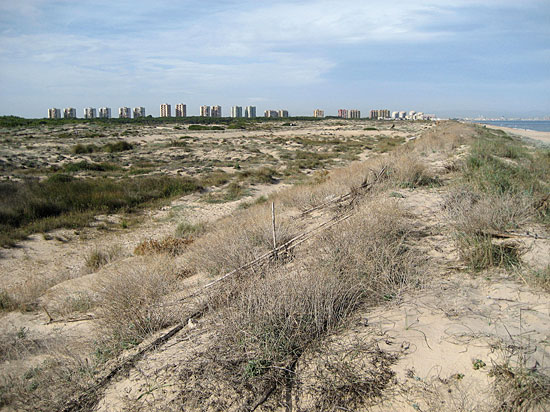From the Ecologists’ Struggle to a Global Priority
The emergence of environmental journalism


The campaigns and actions led by environmental groups, both at a local and global level, have promoted environmental communication by raising public awareness about the need to conserve our environment. / WWF
The environment has come to occupy a place in the news agenda, which it is not going to vacate. The path to achieving this position has been full of hurdles and mishaps from the outset in the late 1970s. This, unquestionably, is because it is one of the areas of journalism that levels most criticism at the bases of the economic system and social model prevailing in developed countries. The allies of environmental reporting have not been, until recently, giants wielding financial clout or prestigious political leaders. However, patent evidence of environmental deterioration and accidents, destruction of habitats and landscapes, loss of biodiversity or the impact of atmospheric emissions on our health, amongst other things, all demonstrate the undeniable importance of environmental news reporting.
This victory of environmental content in the struggle for space and time has been won gradually. Many voices, both individual and collective, have achieved the current prominent position held by environmental issues in the mass media. Silent Spring (1962) by Rachel Carson was a pioneer work in this struggle, while one of the first warnings about the impact of our industrial production model came a decade later, with the work The Limits to Growth (1972), coordinated by the Professor Dennis L. Meadows. That same year, the United Nations set up its «Programme for the environment». Subsequently there have been diagnoses, protocols, European standards, etc., as well as ecological protests and actions, which have not only improved environmental awareness but also provided the counterpoint to information and opinions closer to mainstream development. Natural disasters –brought ever closer to the global village thanks to the development of new transmission technologies– have also helped raise environmental journalism to the vital category, it now holds.
«This victory of environmental content in the struggle for space and time has been won gradually. Many voices, both individual and collective, have achieved the current prominent position held by environmental issues in the mass media»
Within the context of the Earth Summit (1992), the end of the twentieth century witnessed the first period of splendour for environmental reporting in Spain, with the proliferation of magazines like Geo (1989), Ecología y Sociedad (Ecology and Society, 1992), Ecosistemas (Ecosystems, 1992), La Tierra (Earth, 1996) and Biológica (Biological, 1997), although Quercus was already to be found on the newsstands by 1981 and Naturaleza two years after that. Similarly, daily papers started to issue supplements on ecology and the demand for specialised journalists grew. This period also saw the creation of the Journalists’ Association of Environmental Information (Asociación de Periodistas de Información Ambiental, APIA) and the Catalan Association of Scientific Communication, which both promoted the Environmental Information Group (Grupo de Informadores Ambientales, GIA).

WWF
The evils of sensationalism and the climate change bomb
Environmental news, however, has remained in no man’s land –hopping from section to section and flirting with the business pages– while environmental journalists have not become indispensable in the newsroom either. Specialization is one of the great future challenges, which we must tackle in order to put a stop to superficial or unreliable treatment of news about nature and ecology or fall into the trap of trivial sensationalism. And, among others, the daily challenge of deciphering, with the utmost rigor, the complexity and uncertainty of the issue.
Global warming has left an incalculable mark on environmental journalism, as a result of two main issues: global economic impact and the voice of the film industry. The publication of the fourth report of the United Nations Intergovernmental Panel on Climate Change in 2007 represented its launch to fame, with a collateral effect: it eclipsed other environmental issues. The explosion did not happen in isolation, it was preceded by the British Government’s Stern Report, which announced the negative effects climate change would have on the global economy, and the documentary An Inconvenient Truth, by American political leader Al Gore, which we will discuss later in the context of audiovisual reporting.
«Specialization is one of the great future challenges, which we must tackle in order to put a stop to superficial or unreliable treatment of news about nature and ecology or fall into the trap of trivial sensationalism»
The short-term success of contents labelled «climate change» fizzled out with the advent of the current financial crisis. Once again, the health of environmental journalism has proven weak as, with a decline in advertising, environmental issues cannot compete with politics, sports or economy. Not only that, prestigious journalists trained in the environmental sector are also very vulnerable. One resounding case is that of the loss of The New York Times’ influential environmental science journalist Andrew C. Revkin at the end of 2009 and, a year earlier, the decision by CNN to cancel its section on science, technology and environment, and fire the whole team, including Miles O’Brien. Closer to home, the Pompeu Fabra University still runs its prestigious Master of Communication in Science, Environment and Health but last year, essentially for economic reasons, Columbia University decided to scrap its degree in environmental journalism, which it began to run back in 1995.

A mosaic of urban, rural and natural landscapes in Vall de la Valldigna (Valencia). / M. J. Picó
From the printed word to the internet
In the grip of the crisis, environmental journalism remains dormant. It cannot disappear, but nor can it gain ground in weightier sections, like economy. It cannot make progress in the specialization of journalists nor move towards the transversality it desires. Within this scenario, weekly or fortnightly supplements on science, health and the environment, which include advertising, are kept running, such as «Tierra» by El País, «Abc Natural» by Abc or «Eureka» by El Mundo.
The boundaries restricting environmental information in the mainstream media are more relaxed in the Internet. Websites are much more versatile when it comes to providing space for supposedly less prominent issues, like the environment. Thus, electronic newspapers tend to go for exclusive sections, given the digital traffic of readers, though this social demand remains unmet in the printed formats. Sometimes they do so under the heading «Environment» (The Guardian) through more often integrated into the «Science» section (El País, El Mundo, The New York Times), while others offer broader alternatives like «Planète» in Le Monde. Health and technology are two scientific sections currently encroaching on environmental issues, as they enjoy the backing of increasingly powerful lobbies.
«The powerful American, as well as European, audiovisual industries have begun to invest in big productions, catering for both cinema and television»
The environment wins on the Internet, a meeting point of NGOs, environmentalists, foundations, institutions… In Catalonia the digital magazine Sostenible (http://www.sostenible.cat) commands a wide readership, but there are many others just one click away. These sites have created a new type of information supply and demand, which is why the news agency Efe has recently set up a new news service called Efe Verde (Green Efe), led by Arturo Larena. Meanwhile, electronic blogs have opened the gateway to dialogue, where the roles of sender and receiver alternate, with all the dangers and advantages this entails.
The Internet is huge, thus the selection, quality and thoroughness of environmental news becomes a priority. At the same time, we keep alive our ambition of integrating the environment in the daily news on a normal basis, without the need for natural disasters or environmental catastrophes.
The environment and the audiovisual format
Audiovisual formats have always been particularly effective in media communication, particularly those able to go into depth in describing facts and disseminating knowledge, such as reports and documentaries. The former became well established on television from the start, while the documentary has developed in parallel with the movies, fountain from which all audiovisual expression imbibes. Like other forms of discourse, the documentary soon found its place on television. We can even say that, thanks to the film-television binomial, the documentary has been able to enlarge its habitat, which has enabled it to achieve certain stability at a time when audiovisual discourse patterns are subject to constant redefinition and adaptation to new demands. Moreover, in recent times, it has become a format with unprecedented impact, both in the cinema and on television.

The misuse of land and natural resources, beyond sustainable occupation and use, has been one of the environmental issues most widely discussed by the mass media in recent years. Above, sand dunes in El Saler (Valencia), virtually destroyed by a redevelopment project in the seventies, and currently in the process of restoration. Today it is part of the Albufera Natural Park. / M. J. Picó
Scientific and environmental news stories, among others, have benefited from this. On the one hand, because these issues concern and interest the public, who are as interested in the planet’s biodiversity and ecological balance as they are about health, nutrition and technology, among other topics. We could say we are witnessing a «green wave» spanning many social ambits. Labels like «ecological», «organic», «green» or «sustainable» are now common for many products and numerous initiatives. In this sense, it is significant that two national dailies, El País and Público, have been using environmental and nature documentaries in this season’s promotional campaign, that is, marketing strategists have noted that these topics are of growing public interest and that the documentary format is appealing. Also significant is the participation of this type of work in film festivals and the proliferation of topic-specific awards and events, such as the Festival Internacional de Cine Ecológico y de Naturaleza de Canarias (International Film Festival of Ecology and Nature of the Canary Islands), the Biennial International Scientific Film Festival of Ronda, Tele-Natura in Pamplona or Urban-TV in Madrid.
Furthermore, documentaries can explore and disseminate knowledge in depth. Within the context where audiovisual stories have been shortened due to the so-called «clip culture» –an example being the daily news– both documentary and report formats have become discursive forms that, given their morphology, popularize knowledge. Another very important reason for this is because the documentary has enhanced the dramatic component of news stories. This has been made possible, in part, thanks to the improved processes of recording, reproduction and post-production of images. Moreover, we have seen the development of digital and high definition (HDTV) formats, as well as improvements in devices that can incorporate new perspectives to the story, such as micro cameras, remote control cameras, or time-lapse systems, steadycam, macro lenses and telephoto lenses, plus the proliferation of digital animation software. Without underestimating equipment like helicopters, hot-air balloons, ultra-light aircraft that show us another perspective and make productions more appealing.

In the same vein as Oceans, we find the documentary Home (2009). On the left, we see film director, Yan Arthus-Bertran, during the shooting and on the right, one of the spectacular scenes offered by this film, the amazing hot springs of Yellowstone National Park in Wyoming (U.S.A.). / T. Thuaud
Besides, because of the «hybridization» of genres currently characteristic of the audiovisual format, the classical documentary tradition has incorporated elements from other formats typically employed to relate both fact and fiction. Of the former, it has adopted, where appropriate, simplification of production processes as well as other resources like dramatization. Regarding the latter, it has implemented fiction formats to recreate or reconstruct actions that require more complex audiovisual procedures.
All this has led to a popularization of the format, so now it is common for many institutions, companies, research centres, universities, NGOs, or even individuals, to adopt the documentary format to promote their activities. Thus, the University of Valencia concluded the celebration of Darwin year with the presentation its documentary Following Darwin’s footsteps (2010), which relates the theory of evolution with the so-called «Maeso case». This case involved the massive contagion of around 300 people in Valencia with hepatitis C in the nineties. According to the principle of common origin, it could be traced back ancestrally to a single source, as can be done in all living organisms, including viruses.
«Both documentary and report formats have become discursive forms that, given their morphology, popularize knowledge»
This has also led to an improvement in this type of audiovisual production, to the point where it makes up a significant portion of the leisure products in demand. Parallel to the growing interest in this type of production, the powerful American, as well as European, audiovisual industries have begun to invest in big productions, catering for both cinema and television markets. A good example of these recent works are Home (2009), the shooting of which exceeded one year and with an investment of 12 million Euros, and more recently Oceans (2010), with the same film crew as Microcosmos (1996) and Winged Migration (2001), with a budget of 50 million Euros and four years of underwater shooting.
But the production which marked a turning point in promoting the environmental documentary was the aforementioned An Inconvenient Truth (2006), starring Al Gore. Staged in the most spectacular and catastrophic style, An Inconvenient Truth managed to stir up public concern about the effects of global warming and convince spectators of the need to take immediate action, despite containing certain errors, as reported by the scientific community.
However, this momentum the documentary format is currently enjoying would not have been possible without the contributions of David Attenborough, on the BBC, Jacques Cousteau or Spanish television’s Félix Rodríguez de la Fuente and, more recently, following in their footsteps, we have the productions by Joaquín Gutiérrez Acha or Luis Miguel Domínguez, in addition to the enormous output of the National Geographic Society and Discovery Channel. These are dealt with in greater depth in another article in this magazine on television productions.
In short, written communication, be it the printed word or on the Internet, and audiovisual formats together provide a wide range of opportunities to reflect environmental issues, and even hold a place in the agendas of the mass media. Both the mass media and their audiences have shown interest in this topic area, an interest reaching beyond a fleeting trend or fad. Nonetheless, mass media discourse must seek the integration and survival of these issues naturally, reliably and with rigor.
Recommended viewing |
||
| Some interesting documentaries on the environment:Baraka (1992). Dir. Ron Fricke.
Microcosmos (1996). Dir. Claude Nuridsany & Marie Pérennou. Winged Migration (2001). Dir. Jacques Perrin, Jacques Cluzaud & Michel Debats. Darwin’s Nightmare (2005). Dir. Hubert Sauper. March of the Penguins (2005). Dir. Luc Jacquet. An Inconvenient Truth (2006). Dir. Davis Guggenheim. Earth (2007). Dir. Alastair Fothergill & Mark Linfield. Home (2009). Dir. Yann Arthus-Bertran. Following Darwin’s Footsteps (2010). Dir. Harmonia Carmona & Maria Sales. Oceans (2010). Dir. Jacques Perrin & Jacques Cluzaud. |
||
APIA, 2003. Conclusiones del V Congreso Nacional de Periodismo Ambiental. Asociación de Periodistas de Información Ambiental (APIA). Madrid.
Armesto, F. & C. Armesto, 2004. Supervivencia o suicidio. Hacia el futuro de la Humanidad. Alianza Ensayo. Madrid.
Castells, M., 2001. La galaxia internet. Reflexiones sobre Internet, empresa y sociedad. Editorial Areté. Barcelona.
Castells, M., 1999. La era de la información. Economía, sociedad y cultura. Vol. 2. El poder de la identidad. Alianza Editorial. Madrid.
Cerrillo, A. (coord), 2008. El periodismo ambiental. Análisis de un cambio cultural en España. Fundación Gas Natural. Barcelona.
De la Rosa, R., 2001. La revolución ecológica. La búsqueda de la libertad a través de la ecología. Icaria Editorial. Barcelona.
García, E., 2004. Medio Ambiente y sociedad. La civilización industrial y los límites del planeta. Alianza Editorial. Madrid.
Meadows, D.; Randers, J. & D. Meadows, 2004. Limits to Growth: The 30-Year Update. White River Junction, Chelsea Green.
Terradas, J., 2006. Biografia del món. De l’origen de la vida al col·lapse ecològic. Columna. Barcelona.






